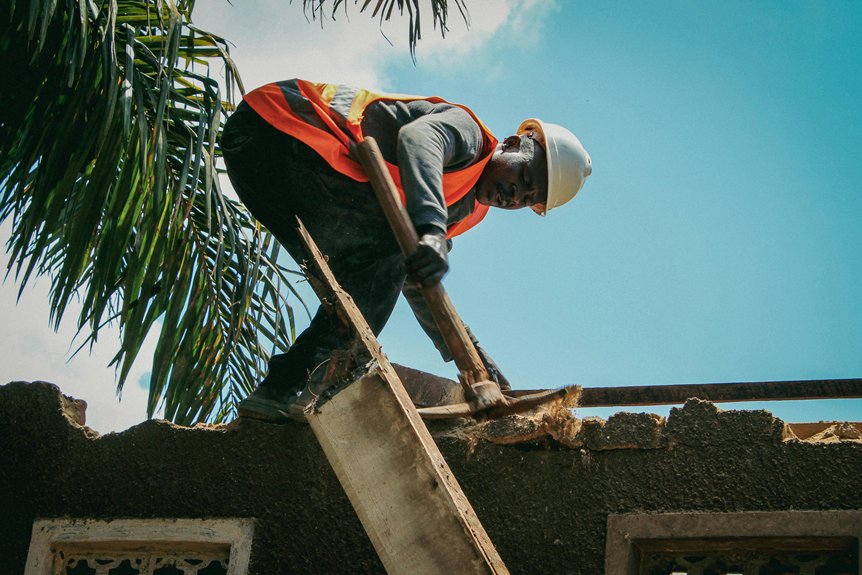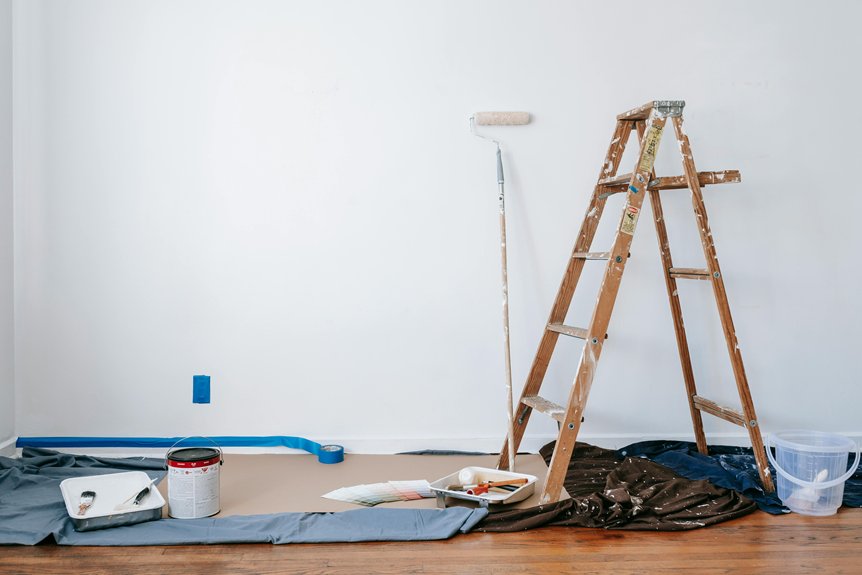When you’re ready to tackle your basement walls, it’s important to approach the project methodically. Start by evaluating the condition of your walls and identifying any potential issues like cracks or mold. Cleaning and preparing the space will set a solid foundation for your remodel. Understanding what comes next can make all the difference in achieving a durable and appealing finish. Let’s explore the steps that will transform your basement into a functional area.
Key Takeaways
- Begin by assessing the basement walls for damage, moisture, and mold, addressing any issues found before remodeling.
- Clean the walls thoroughly to remove dust and debris, ensuring a suitable surface for further work.
- Install appropriate insulation snugly between wall studs to enhance energy efficiency and comfort.
- Apply a vapor barrier, sealing seams and ensuring it faces the warm side to prevent moisture buildup.
- Finish with wall treatments such as paint or drywall, adding trim and lighting to elevate the space’s aesthetics.
Assessing Your Basement Space

Before diving into your basement remodeling project, it’s vital to assess your basement space carefully.
Begin with a thorough space evaluation, measuring the dimensions and identifying any structural features like beams or columns.
Next, conduct a moisture assessment to check for dampness or water damage, as this can affect materials and your overall design.
Conduct a thorough moisture assessment to identify dampness or water damage, ensuring your design remains unaffected and durable.
Look for signs of mold or mildew and consider using a dehumidifier if necessary.
By addressing these factors, you’ll guarantee your remodel is both aesthetically pleasing and structurally sound, setting a solid foundation for your future design plans.
Don’t skip this vital step!
Planning Your Design
Before you start your basement remodel, it’s vital to assess your needs to guarantee the space functions well for you.
Consider how you plan to use the area, whether it’s for a family room, office, or guest suite, as this will guide your design choices.
Additionally, selecting the right materials is critical for durability and aesthetics, so think about options that will withstand moisture and fit your style.
Assessing Your Needs
How do you envision your basement space transforming? Start by evaluating your needs, considering both budget considerations and functional requirements.
Determine what purpose you want the space to serve—whether it’s a cozy family room, an office, or a guest suite.
Think about the layout, storage solutions, and lighting options that suit your lifestyle. Prioritize features that enhance usability while staying within your financial plan.
Create a list of must-haves versus nice-to-haves, ensuring you focus on essentials first. This clear vision will guide your design choices, helping you create a basement that perfectly meets your needs and preferences.
Choosing Materials Wisely
When planning your basement design, choosing the right materials is essential for both aesthetics and functionality.
Consider various material types that suit your style and needs while keeping budget considerations in mind.
- Drywall: Offers a smooth finish and is cost-effective.
- Plywood: Durable and adds a rustic charm but may be pricier.
- Insulated Panels: Great for energy efficiency, though they can stretch your budget.
Evaluate the long-term durability and maintenance of each option to guarantee your investment pays off.
Preparing the Walls
As you begin the journey of remodeling your basement walls, it’s vital to confirm they’re properly prepared to support your project.
Start by inspecting for any signs of damage, such as cracks or mold. Address these issues before proceeding.
Next, focus on wall preparation by cleaning the walls thoroughly to remove dust and debris.
Don’t forget to check for moisture; effective moisture control is essential to prevent future problems. If necessary, use a moisture meter to gauge levels.
Finally, consider applying a sealant to enhance protection against moisture, ensuring your walls are ready for the next steps in your remodel.
Installing Insulation and Vapor Barriers

With your walls prepped and ready, the next step involves installing insulation and vapor barriers to enhance energy efficiency and moisture control.
Start by selecting insulation types suitable for your basement, like fiberglass batts or foam boards. Cut the insulation to fit snugly between the studs.
Choose appropriate insulation for your basement, such as fiberglass batts or foam boards, and ensure a snug fit between the studs.
For vapor barrier installation, use polyethylene sheeting, guaranteeing it covers all exposed areas.
- Seal seams with tape for maximum effectiveness.
- Overlap the vapor barrier at joints and edges.
- Ascertain the barrier faces the warm side of the wall to prevent moisture buildup.
This setup will help keep your basement comfortable and dry.
Finishing Touches
After you’ve installed insulation and vapor barriers, it’s time to focus on the finishing touches that will transform your basement into a functional and inviting space.
Start by selecting wall treatments that suit your style—consider paint, paneling, or drywall to create a polished look.
Don’t forget about final accents; trim, molding, or baseboards can greatly enhance the overall aesthetic. You might also add lighting fixtures or wall sconces to elevate the ambiance.
Confirm all finishes are durable and moisture-resistant, as basements are prone to humidity.
With these elements, your basement walls will be ready for the next phase of your remodel.
Decorating and Furnishing Your New Space

Now that your basement walls are finished, it’s time to think about how you’ll decorate and furnish the space.
Choosing the right wall colors can set the mood, while selecting furniture styles that match your lifestyle will enhance functionality.
Don’t forget to incorporate lighting options; they can dramatically change the feel of your new area and highlight your design choices.
Choosing Wall Colors
How do you choose the perfect wall color for your new basement? Start by contemplating color psychology; different colors evoke distinct emotions. For instance, blues can create a calming effect, while yellows can bring warmth and cheer.
Check out trending palettes that reflect your style, ensuring they harmonize with the rest of your home.
- Test samples on your walls to see how they look in different lighting.
- Think about the room’s purpose; a cozy movie room may need darker tones, while a bright play area may benefit from vibrant hues.
- Don’t forget to take into account the ceiling height and existing furnishings!
Selecting Furniture Styles
Selecting the right furniture style for your newly remodeled basement can greatly enhance its functionality and aesthetics.
Consider modern aesthetics that blend seamlessly with your design choices. Opt for sleek, minimalist pieces that create open, functional layouts, allowing for easy movement and versatility.
Think about multi-functional furniture, like a sofa bed or an ottoman with storage, to maximize space. Incorporate a mix of textures and colors to maintain visual interest while sticking to a cohesive theme.
Finally, guarantee your furniture complements any existing features in the basement, creating a harmonious environment that’s both inviting and practical for everyday use.
Incorporating Lighting Options

While you may have focused on furniture and decor, incorporating effective lighting options is essential to transforming your newly remodeled basement into a welcoming and functional space.
Consider these key elements:
- Ambient lighting: Use soft fixtures to create a cozy atmosphere, perfect for relaxation.
- Recessed fixtures: Install these in the ceiling to save space and provide targeted illumination without overwhelming the room.
- Accent lighting: Highlight artwork or architectural features, adding character and depth.
Conclusion
By following this step-by-step guide, you can transform your basement walls into a functional and inviting space. Remember to assess your area carefully, address any moisture issues, and choose the right materials for insulation and finishing. With attention to detail in your design and decoration, you’ll create a cozy environment that enhances your home’s value and usability. Don’t rush the process—take your time to guarantee a quality remodel that you’ll enjoy for years to come.



